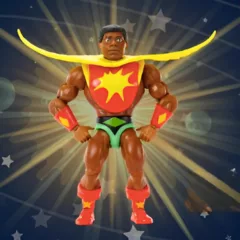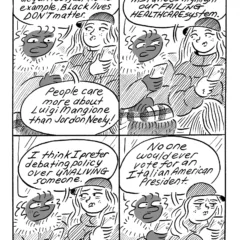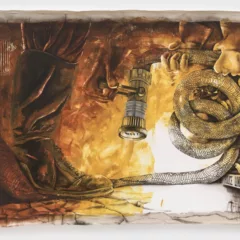Hi Philly Art Blog,
Question: Can Art be damaging. (Can it harm?) Specifically with regard to Mental Health and/or Racism.
Thank you
Hope all is well
Jay
Hi Jay,
Thank you for your question. Yes. Art can harm. That’s it. That’s the advice column.
Ok, ok, for the sake of filling some white space, as a curator might say, heh, let’s elaborate. Not only can art harm, but should it? Mostly, art is for adults, it comes with a description. If you think you cannot handle the exhibit or are just not at all interested – don’t go see it. If, in spite of your unease with the subject you go see the exhibit, then being damaged, psychologically speaking, is inevitable, but the only way out is through. See, even Robert Frost is depressing.
Aesthetics aside let’s get into art that deals with the harsh realities of life, that is, politics. Well, political art is an aesthetic, but that’s another article. When it comes to tragedy in art more often than not the art is political. No worries, I haven’t seen “The Joker”, not that kind of thinkpiece. As in not shallow. I have many straws I want to grasp at here, in relation to art under the curtain of politics in the U.S.; racism, sexism, safe spaces and cancel culture, so bear with me as pull the first one.
Welcome to my echo chamber.
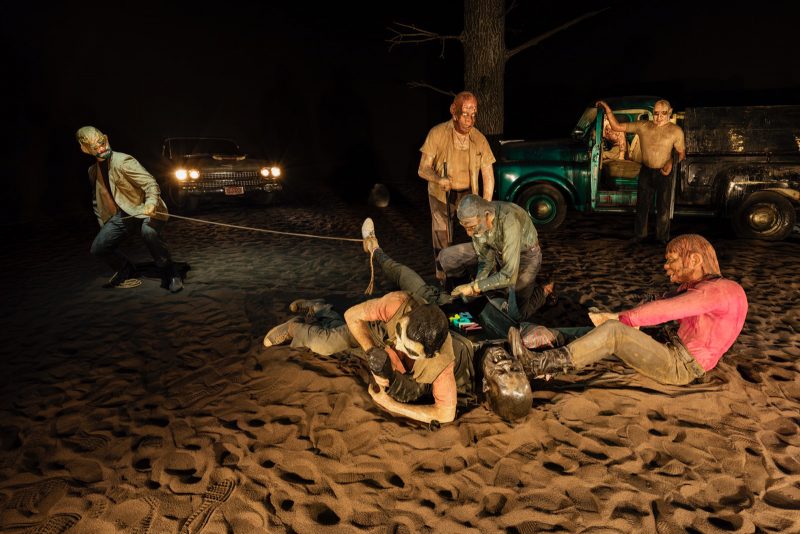
There is one artwork that comes to mind as particularly damaging and I’ve never even seen it in person, Edward Kienholz’s “Five Car Stud 1969-1972”. A fictional life size diorama of a black man being castrated for dating a white woman by five white men with the white girlfriend and white child of one of the attackers looking on to the horrifying scene. It’s depicted at nighttime with car headlights alighting the scene. It is a truly sickening sight and an accurate depiction of racism in the United States in 1972 that still resonates today. The artwork premiered in Germany at Documenta 5 in 1972, receiving positive criticism, and was then stored by a Japanese collector for 40 years before making a tour to the United States through 2011-2012. The artwork even comes with a tagline from the artist which appropriately sums up “Five Car Stud 1969-1972” in conjunction with the Civil Rights Movement, “If six to one is unfair odds in my tableau, then 170 million to 20 million is sure as hell unfair odds in my country.” Though the work was mysteriously put in storage for 40 years after receiving positive criticism, described as one of Kienholz’s most significant installations, when it toured in the US in 2011-2012, with a content warning, it received no outcry from the public, where commonly today contemporary artists would face being questioned on their ethnicity and/or for being politically exploitative along with a demand that the artwork be destroyed. Were we at that time on the cusp of something?
Is it that an artist making work today is more so obligated to a social moral code of conduct than an artist of the past? A dead artist, like Kienholz, who died in 1994 and wasn’t around in 2011 when the piece toured the country? Today through social media, our ability to spread information, even past indiscretions, could unravel your redemption. Like in the instance of poet Frank Sherlock who came under fire on social media after being outed as a white nationalist at the age of 19 before changing directions in his life and art through community activism. The narrative derived from every article I read on the subject was that he was mostly vilified for receiving a Pew Fellowship in 2013. From the Inquirer story, Rasheedah Phillips, a lawyer, artist, and AfroFuturist, comments on the grounds of whether Frank Sherlock should be forgiven for his past, “As a white person, you get to say it’s a youthful indiscretion, as a black person, the consequence for youthful indiscretion is lifelong poverty and jail.” So, no.
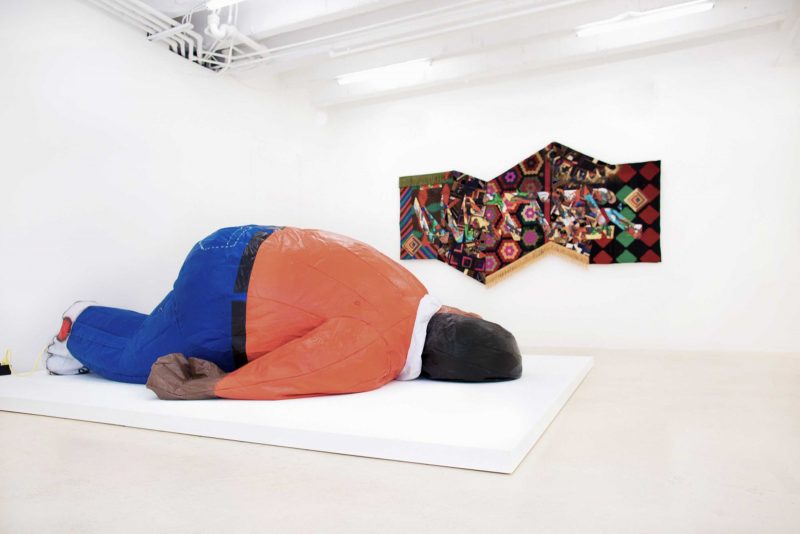
There’s an article I had read by Taylor Renee Aldridge in artNEWS a few years ago which came to mind about a figure sculpture by Sanford Biggers entitled “Laocoön”. The article is entitled “Black Bodies, White Cubes: The Problem with Contemporary Art’s Appropriation of Race”. While today typically an artist’s race and artistic license are called into question when they make an artwork about racism, Sanford Biggers is an African-American artist. And the author calls into question the curation, describing within the onset of the article the gallery itself being in “a wealthy neighborhood of Miami Beach” (furthermore debuting at an art fair). Aldridge goes on to describe “a festive group of gallery goers, sipping wine, taking pictures of the panting body. The scene was grotesque.” Aldridge is viewing this entire scene from their Instagram. In other words, you can sum up the whole tableau as “tacky”.
“Laocoön” is a large scale inflatable sculpture of the cartoon character Fat Albert, inflating and deflating. Biggers describes the work, “He’s on a pump, so he’s actually breathing his last breaths”. Though Biggers claims the work does not represent a specific death, stating “That piece was born out of a lifetime of this dysfunctional relationship between African-Americans and America—not anything that happened within the last four or five years…”, Aldridge assumes a highly contemporary reference in their article. Writer Aldridge, viewing the work at the height of Black Lives Matter aligns the image specifically to that of Michael Brown, whose death at the hands of police in Ferguson, MO, was portrayed far and wide mainly due to the police’s negligence and disrespect for human life in failing to cover Michael Brown’s dead body lying face down in the street.
The sculpture is an uncanny depiction. While I cast doubt on writing entire scathing critiques of an artwork from your Instagram account, I am intrigued by Aldrige’s calling into context the stark commercial white backdrop of the art gallery, most importantly the art fair – as a means to baring America’s violent racist atrocities. Alternatively, the article I quoted for Sanford Biggers’s statements about “Laocoön” is entitled “The Playful, Political Art of Sanford Biggers”. I wonder if a white artist made this work if it would even be accepted or covered in The New Yorker as playful?
I view “Laocoön” as a spectacle meant to jar your senses and confuse your reaction. Laughter is a hard-wired reaction to a horrific event. Look it up. Comedy and tragedy are bedfellows, aligning the two is not in poor taste. This kind of artwork needs to be allowed to exist. “Laocoön” does specifically call to the image of Michael Brown, whether Biggers intentionally did so or not. Clearly, race grants you artistic license when creating a work of art otherwise The New Yorker would not be describing your work about racism in America as playful, artistic intention aside. Aldridge is not criticizing Biggers as being a black artist, (specifically an African-American artist, black artists not born and raised in the United States have been criticized for making artwork about racism in America), they are criticizing them for exploiting Michael Brown’s death. Aldridge states, “Too often, I wonder if artists responding to Black Lives Matter are doing so because they truly are concerned about black lives, or if they simply recognize the financial and critical benefits that go along with creating work around these subjects.” Tokenism is the shallow gesture used in including artists outside the white male dominated institutional space that in the end creates no real structural change – like identity politics. Can this same word be turned towards artists who make art to play into this sort of curation?
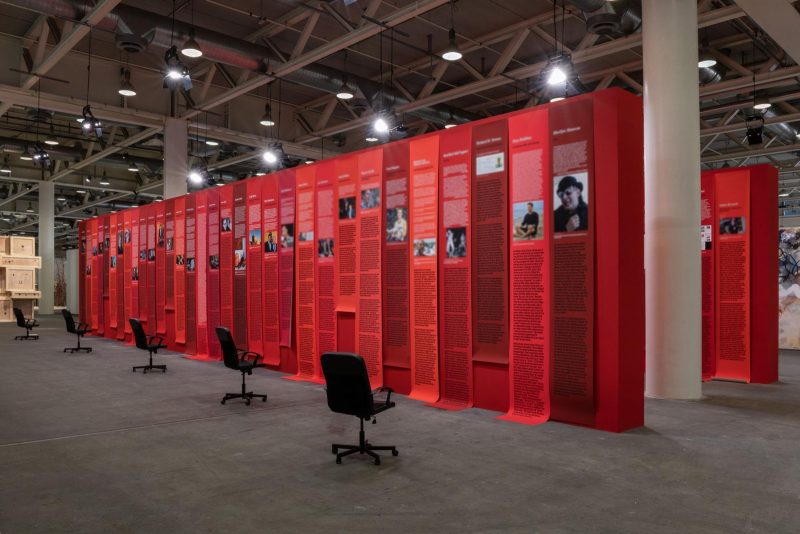
In reference to your question, I bring us back to the blog, it does seem to be unnecessarily harmful to an art audience to be subjected to not only the face of racism, but as well the face of commerce. We do however, seem ok with this open exchange between art and commerce within movies and television. Just saying. I want art to be better too.
Another artist, Andrea Bowers, came across as tack-city recently from another art fair, Art Basel, when they appropriated images from Helen Donahue’s Twitter account for their massive #meToo installation entitled “open secret (2018-2019)”. The appropriated images depicted bruises inflicted on Donahue by Michael Hafford, an ex-VICE magazine colleague. Bowers published the images without Donahue’s permission, among many other tweets as part of the piece. Upon discovering the work, Donahue tweeted “cool that my fucking photos and trauma are heading art basel thx for exploiting us for “art” ANDREA BOWERS @unavailabl DO YOU KNOW HOW FUCKING INSANE IT IS TO FIND OUT MY BEAT UP FACE AND BODY ARE ON DISPLAY AS ART RN FOR RICH PPL TO GAWK AT THRU A STRANGER’S INSTAGRAM STORY” This is unnecessary harm in the guise of exploitation within political art. Originally the work was priced at $300,000, listed as such within the first paragraph of every article about the controversy, and later it was decided not to offer the work for sale out of respect for the survivors.
Calling further back, just a little, a nearly impossible not to mention case – Dana Schutz’s “Open Casket”, a painterly depiction of the brutally defaced Emmett Till, a young black boy who was beaten to death for catcalling a white woman who later confessed to making it all up. Dana Schutz was called to destroy the painting on the basis of her whiteness from artist Hannah Black, “The subject matter is not Schutz’s; white free speech and white creative freedom have been founded on the constraint of others, and are not natural rights.” There was also the underlying truth of the matter that Schutz is also a wealthy white woman. The spectacle of art commerce heightens the pain of a work of art – as its patronage, like all patronage in the United States, delineates from white supremacy, otherwise known as Chelsea.
Artists are entitled to free speech regardless of their ethnicity, gender or sexual orientation in order to create art. Regardless of whether they are a good person. When ruminating about your question, I could not help but think of cancel culture, where at the pit of my stomach I feel it is bad for art. If we are so afraid to be harmful, to be the bad person, and on the flip side to be harmed, to be the good person – we will just continue to go in circles. We learn nothing. Let me break this to you, reader, you are not a good person because you are inherently human. When casting judgement between right and wrong, a truly just person should never truly feel right.
Artists must be free to make mistakes, to be flawed in order to make great art, because great art is about being inherently human. Should Andrea Bowers have apologized for making “open secret (2018-2019)”? No. I do not agree with her choice to clearly make a profit off #meToo by displaying women’s bruised bodies at a fucking art fair. And I swear if I see another work of art with swivel chairs it will be too soon. I do see her mistake(s), but I also think artists should be free to appropriate and be paid to make their artwork. I can see how Bowers might have assumed that Donahue putting this image on Twitter for all to see to begin with was giving the artist permission. She failed to see the nuance of irl.
There is a gray area within the realm of profiting off political art. There are many, many women profiting off the #meToo movement via their creative pursuits. Do I buy it? No. I’m not entirely behind the victimization of mostly wealthy to middle class white women, don’t @ me. Today we have so many images to cull from it’s confusing when to ask for permission. A person was harmed in the making of this artwork. Andrea Bowers caused Helen Donahue mental duress. Andrea Bowers should have asked, but in not asking we are able to have these discussions and further bring into context the world we live in. Her mistake, dare I say, is the art. A-hah! So it is, the age-old question is solved. Art imitates life. Aristotle 1. Oscar Wilde 0.
I’m sure people disagree with me that an artist should never apologize, so let me make my case. To make art you must be amoral. Camile Paglia from her recent collection of essays “FREE WOMEN FREE MEN” discusses an artist’s moral responsibility, “Baudelaire and Oscar Wilde knew neither art or the artist has a moral responsibility to liberal social causes.” Wilde’s “The Picture of Dorian Gray” is as relatable today as it was when it was written over a hundred years ago. I believe art is a mirror. We should take a good look at what is staring back at us before deciding if it should be destroyed or hidden behind a curtain. Moral superiority is insufferable. Because to be moral means to be status quo. An artist must be avant-garde. Besides, you can’t write the villain without being able to empathize with the villain. This approach is a topic of discussion in a recent interview with Ta-Nehisi Coates discussing his new book “The Water Dancer” on Fresh Air with Terry Gross. (go listen to it) When Terry asks “Tell me about imagining yourself as a slave owner when writing the book,” Coates imagines living in the society of the time, as a white person, where white people who did not own slaves were described as “poor quality whites”. He further approaches slavery as a system where in an individual of courage is most often not present. Most individuals intrinsically are part of a system, go with the system, including a person who Coates read about as research in relating to his character, a slave owner, Thomas Jefferson.
Temple Contemporary had a lecture on cancel culture in October 2019 with Svetlana Mintcheva, Art Historian and Director of Programs for the NCAC (National Coalition Against Censorship), “Cancel Culture: Can Free Speech Survive the Onslaught of Moral Outrage?”. Mintcheva’s overarching argument was that America’s shift into a more multicultural political landscape without paying homage to its past cruelties is creating a backlash. Today liberal social causes lean mostly towards political correctness — to a fault. While I understand safe spaces have come into fashion on the premise that people were being excluded, creating another club will only further alienation. Surrounding yourself with oneness only excludes you.
I found a comprehensive argument on this topic in Julia Serano’s book “Whipping Girl” which is a collection of essays critiquing feminism, sociology and psychology dealing with transgenderism. In the consideration of creating safe spaces Serano points to a pattern within feminist groups, wholly described as T.E.R.F.s, Trans Exclusive Radical Feminists, who exclude trans women from queer spaces today. She furthermore commemorates the LGBTQ movement for their assimilation politics that led to gay culture becoming part of mainstream society which led to political victories in the U.S. like gay marriage. “Thinking in terms of alliances can encourage us to move beyond the single goal of creating safe queer/trans spaces, to recognize that, in reality, there is no such thing as a “safe space,” Serano writes. After all, the very notion of safety is often predicated on presumed and exclusionary sense of “sameness” and “oneness”.” In Mintcheva’s lecture she argues that safe spaces shut down discourse resulting in artists’ work being banned, censored or blacklisted on the grounds of making people feel uncomfortable.
The crux of Mintcheva’s lecture, educational institutions, including our art museums, must be places that allow free speech. Allow free speech as in, museums that get government funding get speech protected under the first amendment but institutions which are reliant on private funding do not. Basically, you protest all you want outside Wawa, but inside Wawa they have every right to kick you out. And if you smoke weed at Independence Hall, a National Historic Park, protesting against the criminalization of marijuana and you’re white…it’s a court case. Hey, we live in a society. Every display of protest inside an art museum that you see, is tolerated, until they are kicked out for burning sage or something. Trust me, I know, I’m a guerrilla performance artist. The artwork as well. If the board doesn’t like an artist or deems their work offensive or dangerous to them – it’s censored. If we, the public deem it so, it takes a whole lot more to get our say if we even get a say. Go see Hans Haacke at The New Museum and support the New Museum Union while your at it – and all your local art handlers while you’re at it. Heh. Fuck capitalism. This is why I am against billionaires/millionaires being a primary source of funding for our art museums…and government. Tax me for my art museum! Closing paragraph.
When considering cancel culture I see an undeniable pattern beyond race, gender or sexual identity – it’s about money. Essentially cancelling someone is firing them. The people cancelling are the disenfranchised. And considering the disparity of wealth in our country evidenced by the billionaire class, aka trickle down my ass, there are a lot of us who are disenfranchised. Wealth inequality as I see it, is the cause of cancel culture. The late capitalism answer to being powerless against corporations is to deplatform them. Ellen Degeneres can explain away her sitting next to George W. Bush in an act of sad clown standup daytime talk show performance art — the message is clear, her lesbian assimilation is complete, she is now wealthy. You can really tell I wrote this in October, well, at least we all know Epstein didn’t kill himself. I am all for cancelling rich people. Most (poor) artists, myself included, love to see a wealthy artist go down. We’re jealous. We want what they have, money, er, success. The disparity of wealth in the economy is reflected within the art world. The majority of the wealth is given to artists within the 1%. If you’re the one being cancelled chances are it’s because you are a bad person, but also it’s because you are successful. “The thermometer of success is merely the jealousy of the malcontents.” Thank you Salvidor Dali. The only way out I see is through – making the artist anonymous or somehow take away the individual artist through the scope of defining genius. The art will continue to mirror the viewer, in other words, be uncomfortable to look at.
Did I answer your question? Lol
Best,
Beth, Willing to Fight for Someone I Don’t Know


